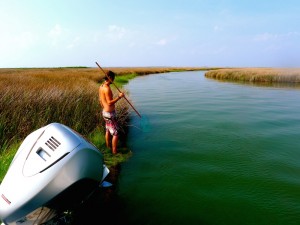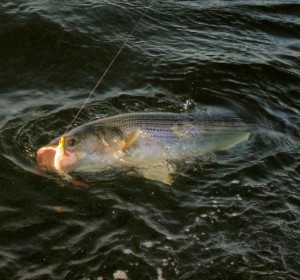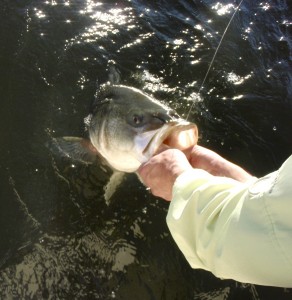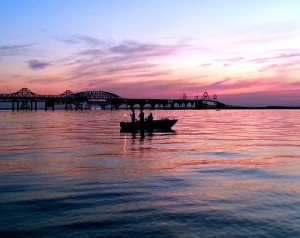 I hang with a lot of fisheries guys. If I had to guess at the backgrounds of the people I’ve fished with most frequently, it would be (in order) coaching baseball, cutting meat, and studying fish. My brother is a fisheries biologist as are many of my friends. I was thrilled recently when a young fisherman who is still in high school reached out to me about his career plans, “I want to be a fish scientist,” he said. “I want to make a difference.” Obviously, I appreciate those guys and the science in which they work.
I hang with a lot of fisheries guys. If I had to guess at the backgrounds of the people I’ve fished with most frequently, it would be (in order) coaching baseball, cutting meat, and studying fish. My brother is a fisheries biologist as are many of my friends. I was thrilled recently when a young fisherman who is still in high school reached out to me about his career plans, “I want to be a fish scientist,” he said. “I want to make a difference.” Obviously, I appreciate those guys and the science in which they work.
I looked up the term Fisheries Management and found this: Fisheries management draws on fisheries science in order to find ways to protect fishery resources.
I like the phrase, “draws on fisheries science.” As a fisherman and a conservationist, I want management decisions based on facts, not politics, pseudoscience, or hearsay. I am a student of the collective knowledge acquired by fishermen. There’s nothing I’d rather hear than the recommendations of a seasoned angler or the sage advice of an experienced waterman. On the other hand, I work in a scientific profession, so I recognize that good science trumps folklore on every occasion.
 The Atlantic States Marine Fisheries Commission (ASMFC) is currently seeking public comment on a Draft Addendum 4 that could significantly change the way they manage striped bass. It’s a big step because, historically, change doesn’t come easy with this organization. You’d think that, when considering something so significant as harvest reductions, they’d tread very carefully and rely only on the best research, right?
The Atlantic States Marine Fisheries Commission (ASMFC) is currently seeking public comment on a Draft Addendum 4 that could significantly change the way they manage striped bass. It’s a big step because, historically, change doesn’t come easy with this organization. You’d think that, when considering something so significant as harvest reductions, they’d tread very carefully and rely only on the best research, right?
Take a look at any fisheries management plan and you’re likely to see the term “best available science.” That phrase shows up in documents like The Magnuson-Stevens Act, the primary law governing fisheries management in the United States, and in the ASMFC’s own charter. These days, a lot of people are scratching their heads wondering exactly what passes for the “best available science.”
The decades when Maryland led the nation in striped bass research are long gone. The state has other priorities for its money now, most of which have very little to do with conserving our State Fish. My guess is that our Department of Natural Resources spends more money convincing people to eat striped bass than they do on research to study the way the fish behave. That’s too bad, because the void left by the absence of good scientific data is being filled with opinion and conjecture.
In addition to money and time, good science takes committed individuals who can investigate without bias or prejudice. I work for a major research university where I constantly collect data for human investigations. In the medical world, we are urged to guard carefully against “confirmation bias.” In other words, in addition to working to confirm our theories, we hope to keep an open mind to other possible alternatives and outcomes. It’s important to realize going into a project that a disproven theory can be more valuable than an initial assumption. Talk to a good scientist about the possible outcome of any investigation he’s working on and the three-word sentence you are most likely to here is “I don’t know.”
 Good science lets the results dictate the opinion, not the other way around. Oh, we all have our prejudices, but good science does not begin as an attempt to justify past actions (for example, a bad management decision), nor does it seek to prove a hypothesis that cannot be overturned. Good scientists stay out of political arguments and concentrate on the facts at hand. They don’t have political agendas.
Good science lets the results dictate the opinion, not the other way around. Oh, we all have our prejudices, but good science does not begin as an attempt to justify past actions (for example, a bad management decision), nor does it seek to prove a hypothesis that cannot be overturned. Good scientists stay out of political arguments and concentrate on the facts at hand. They don’t have political agendas.
In good science, a theory becomes legitimate by the process of peer review and replication. That means that it is scrutinized and critiqued by other scientists, some of whom may have drastically differing opinions. The peer review process is what separates real scientists from the pseudoscientists who set up quasi-elaborate experiments to espouse their personal beliefs. Peer review is the cornerstone of scientific research and the single most important tool in maintaining public confidence in any decision-making process.
Other than medicine, I can’t think of anywhere that public confidence is more important than in taking care of a publicly owned resource like the fish in the Chesapeake Bay. When we see evidence of pseudoscientific theories (no matter how well intended) in position papers and other official documents, it’s time for someone to blow the whistle.
Here are some examples: A recent position paper submitted to the ASMFC by Chesapeake Bay states, Maryland, Virginia, and the Potomac River Commission, made the claim that there are substantially more male fish than females in the Chesapeake Bay. Is that true? It makes sense that female fish leave the Bay sooner, but what about all those fish we catch with green eggs in them in June and July? And how about those big fish in late fall and winter at the Bridge Tunnel? If it’s true that a lot more fish are male, then it’s a premise we should support for future reference points. But what if it isn’t? Where is the research? Is this science, pseudoscience, or just something somebody made up?
To complicate matters, that apparently unsupported claim made it to the desks of our two U.S. Senators, Barbara Mikulski and Ben Cardin. They included it in a co-signed letter to the ASMFC that asked for delays in striped bass harvest reductions. I called to ask what they were thinking and one staffer seemed surprised to learn that there is another side to the story. She was even more surprised to find out that there is a huge block of conservation voters who are unhappy with their positions. She told me they have to rely on state agencies for their assumptions. I suggested they dig a little deeper next time. Would you rather your Senators make assumptions based on science, pseudoscience, or just something somebody made up?
Another example is the claim that striped bass are eating all the crabs, or all the weakfish, or the shad, or the river herring, or you pick the species. That story has been floating around for a while in the Chesapeake Bay. It almost seems like people believe that if they repeat it enough, it will make it true. The statement is also included in the same position paper that alleges a preponderance of male fish, and is an item in the ASMFC’s Draft Addendum 4. We all know that fish eat other fish, but how significant is natural predation to the management of those species? Does it make sense to pin all the blame on striped bass for a decline in species that are heavily harvested by humans? Haven’t these fish always eaten each other? Where is the research? Is this science, pseudoscience, or just something somebody made up?
 Obviously, the fisheries managers in the Chesapeake Bay states feel like they’re getting the short end of the stick as the ASMFC considers harvest reductions to striped bass. They’re pulling out all the stops to whittle away at proposed cuts. They’re even cherry-picking data from different years, proposing cuts based on past harvest for some areas, past quotas for others, and mortality estimates from whenever suits their purpose. I believe harvest reductions are way overdue and should be based on the most recent data available. They should be equally distributed across recreational and commercial sectors in every state.
Obviously, the fisheries managers in the Chesapeake Bay states feel like they’re getting the short end of the stick as the ASMFC considers harvest reductions to striped bass. They’re pulling out all the stops to whittle away at proposed cuts. They’re even cherry-picking data from different years, proposing cuts based on past harvest for some areas, past quotas for others, and mortality estimates from whenever suits their purpose. I believe harvest reductions are way overdue and should be based on the most recent data available. They should be equally distributed across recreational and commercial sectors in every state.
No matter how you feel about the reductions recommended in Draft Addendum 4, one thing is certain: fisheries science and fisheries management is tough work. There are thousands of different opinions and simply no way to please every user group. In my perfect world, fisheries managers would resolve all conflicts with good science. In other words, they would put the fish first and let everything else follow course. We can argue over how the data are interpreted or implemented in practice, but a good scientific foundation will always stand on its own.
Here are my questions: When it comes to fisheries management decisions, why not just rely on the facts? Why don’t we hear “I don’t know,” when the fisheries scientists really don’t know? In cases where there isn’t enough data, why not use some of those seafood-promotion dollars to figure out how to keep the species that industry harvests sustainable?
When politics, hearsay, and conjecture make their way into the management process, distrust becomes rampant. In matters involving the preservation of our public resources, we shouldn’t be left to wonder if this is science, pseudoscience, or just something somebody made up.




Excellent article Shawn. Hope it is widely read.
Based on many years of observing the actions of fish managers at the ASMFC and in Maryland and Virginia, decisions seem to be strongly based on “just something somebody made up”, followed by “pseudoscience” with actual science taking a back seat. Money and politics seem to be the driving force, not what is best for the fish.
That about sums it up.
Excellent article.
I am a big admirer of yours Shaun. Your site is excellent and widely respected in town. On labor day several of us were boarded by the NRP for no reason and given a safety check at sunset. Total BS and an invasion of our civil rights. I am sure this has happened to a lot of your readers. I was hoping you would share my short (very amateur) film of my GoPro footage with your readers.
https://www.youtube.com/watch?v=SErZGeml5lk
Rick
I think most of us would prefer not to be checked during prime time at sunset or when the bite is really on. NRP officers do safety checks when they have time to do them. There is no harassment involved. None of your rights were violated.
The most interesting thing about the vid to me was the interaction of your dog with the officers. I thought he may jump in their boat. The other thing I noticed was both officers tried to keep their boat from banging your boat. That is often not the case.
They did not bang my boat because I pointed out the GoPro. My buddy Dave was not so lucky. They banged him up good.I steadfastly believe that there should be a limit to the powers of the NRP. We can agree to disagree.
I showed my pic to my 3 daughters (my harshest critic’s) and they said my message was not clear, so I tried again. We all agree that my dog Fin sucks in the role of the “scared old dog”. It does appear that he tried to lick the captain. You guys, like it or not, have become the voice of the rec. fisherman and probably would have been as upset as I was. I am on the board of Stripers Forever and can provide you with some eye opening revenue figures we bring to the state. This entire thread is about how the DNR and others are lying to us and risking the very existence of our hobby. The officers were perfect gentleman, its not about them. I just want some respect and think their focus needs to be shifted away from being pests to the very people who pay their salary. If you guys (Shawn, Brandon,lateral line et el) agree, then let’s make our position clear. Go easy on my film. It started as a practice with IMovie, so I can share some Western shore topwater action. I want to learn how to make my 17 inchers look like 30″s.
https://www.youtube.com/watch?v=YkhUC9q-vUs
Working at a cross-town “major research university” I think you make a good comparison between the practice of medicine and fisheries management. Both are (should be) scientific. But it’s alarming how often this is not the case. Imagine a checklist to verify the correct site of surgery, that is proven effective, but not used. Can you say “Whoops we cut off the wrong leg”? It happens. But the major difference between medicine and fisheries management is that medicine has mountains of research to review, thick journals published monthly. The best, and most respected docs know the research, leave pseudoscience out of the equation, and consistently make evidence-based decisions. They tend to talk less and accomplish more because they don’t need discussion groups to move ahead. Lacking the research in fisheries management we practice politics not science. Brings to mind a shark fishing trip my buddy and our kids went on in Ocean City. It was a blast! Our captain also weighed, measured, and tagged the 19 sharks we caught. Research dollars will always be scarce. But anglers and charter captains are an under utilized source of data. I wonder what we could add to fisheries research if we put our minds to it.
I work in fisheries and I can tell you that it is indeed another world. There are some very good scientists in our field, and some that are not so good. As the other writers have pointed out, there is a lot of politics involved and not only in interpreting the results, but in the types of projects that are selected for funding. To be quite honest, the best research comes from scientists with connections to the seafood industry since that’s where the money comes from. I believe Maryland has some excellent scientists and very good fisheries research going on, particularly projects by the University of Maryland, including the Institute in Baltimore, Horn Point, & Secor Labs. I agree with you that the statements about male fish and natural predation made by Maryland DNR are troubling if there is no scientific evidence to support.
After more than 40 years at major research universities in a completely different field, it is appalling to me as I learn more about the management of my new retired passion of fishing for striped bass. Great article Shawn, but I worry that the politicians & their staffs will never understand the difference between science and pseudoscience.
Shawn,
Though we have never quite met……almost on James Sloat’s boat out of OC last winter, and the almost fishing at Cape Cod……I was down at the Lock’n Festival this weekend, and was definitely thinking you would have loved it….did you go? They had some great bluegrass, as well as some great blended tunes. The Grateful Grass set on the forest stage was fantastic with Keller Williams. Also, you would have like Sam Bush/Larry Keel……great stuff. Oh, and one of the best parts was a guy we were camping next to who brought the nicest spread of food….home made country sausage, pulled pork from NC, crab cakes…..country bacon…..ate like a king. Hope to meet you at some point.
Excellent article Shawn, as always, you’ve not only improved my fishing but broadened my understanding onservation efforts and the politics involved. I recently heard another side of the Conowengo Dam issue which made me even more concerned about where policy makers get their facts and who is controlling it.
The Conowengo issue is merely a smoke screen being used by some Eastern Shore counties as an excuse not to meet Bay Cleanup requirements. It is being fueled by an anti-conservation group of right-wing lawyers in Baltimore. There may be some issues with sediments behind the dam, but to use it as an excuse not to clean up the Bay should be criminal.
Brilliant, I wish I’d seen this sooner I heard the “mostly males” argument repeated at the asmfc public comment presentation the other night and wondered if there was any science behind it. There was an upper bay
state senator trying to win points with the “Conowingo toxins need study before anything happens” red herring/stall.
So where is the science that refutes the more male theory ? Same with the Conowingo effect ?
So where is the science that refutes the more male theory ? Same with the Conowingo effect ? Do you need a scientist to figure the slaughter of pregnant females by “sport fisherman” this Spring was STUPID ! Would “sport fisherman” support or allow that kind of activity by another user group ? Without spending a dime on a study I feel confident in my assessment hell
no !
Michael, that’s the point, there is no science to refute the more-males theory because there is no science to support it. There’s just some random surveys done here and there. That’s not me saying that, it’s the Technical Committee of the ASMFC and it’s a big reason why we don’t have dedicated Chesapeake Bay reference points. If it’s true that there are a lot more males, that should be pretty easy to prove. Why isn’t it proven?
I’m not deep enough into the Conowingo dam situation to know if there has been any scientific examination or not. I’m sure there is a looming problem there, but I agree with the previous comments that it is being used as a red herring by some of the Eastern Shore counties because they don’t want to spend the money to clean up their discharge into the Bay. In other words, it’s a lot easier for those counties to point the finger elsewhere than to clean up their own backyards. Unfortunately, they’re spending way too much of our tax money paying some law firm in Baltimore to sue when they should be upgrading their sewer plants and enforcing their runoff laws. If we really care about cleaning up the Bay, we’ll address both the dam situation, and the problem with local pollution.
Now, as for the slaughter of pregnant females in the spring, you won’t get any argument from me.